






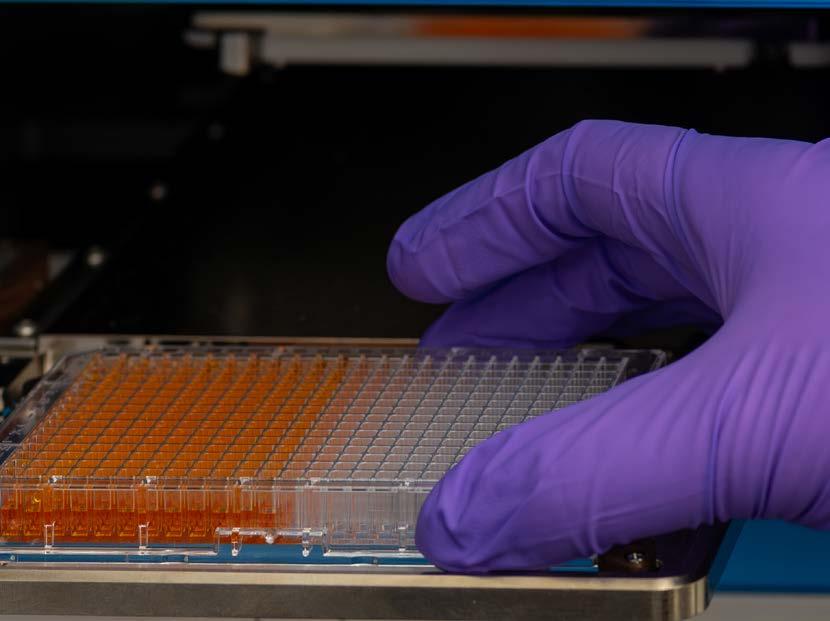
Our Vision
A world where everyone has access to safe and affordable medicines which allow individuals to manage their health, preventing diseases impacting their lives.
Our Mission
To use our world-leading expertise, working in global partnerships, to develop new medicines for diseases of unmet medical need that affect millions of people across the world and have a global economic impact.
Our Purpose
To deliver high quality drug candidates that will translate from the lab to the clinic. We do this through science-led development of the path to the clinic, application of drug discovery innovation and collaboration.

I have closely observed the growth of the Dundee Drug Discovery Unit (DDU) over a number of years, both in my former role as R&D Director at the Drugs for Neglected Diseases initiative and as Chair of two scientific advisory boards for DDU: the Kinetoplastid drug discovery project and the Wellcome Centre for Anti-Infectives Research. During this time, I have seen the DDU grow into a multidisciplinary team of excellent scientists unravelling new biology while applying the latest technologies to discover innovative therapies for treatment of neglected infectious diseases. The importance of developing new medicines for neglected patients cannot be over-stated and the DDU is making major contributions. This is exemplified in clinical stage drug candidates such as the anti-malarial compound cabamaquine transferred to Merck KGaA in Phase 2 clinical studies in Africa and two clinical candidates against visceral leishmaniasis: one inhibiting a protein kinase called CRK12, and the other inhibiting the proteasome.
The DDU has many productive interactions with other research groups in the neglected infectious disease community. Such interactions are important and essential to overcome the challenges of finding innovative therapies
to meet the needs of neglected disease patients. A growing pipeline of new therapeutic drug candidates is demonstration of the success of these endeavours, as well as a highly regarded output of scientific publications. Underlying this success is the application of integrated approaches to drug discovery and elucidation of the key mechanisms and pathways driving disease biology that DDU and its partner organisations have exploited. Considering the size and funding of the DDU, their work to build a portfolio of drug candidates is to be commended but much remains to be done to adequately fill the drug pipelines to meet the burden of neglected disease patients.
In addition to tackling neglected infectious diseases, the DDU is making laudable progress tackling novel targets in non-infectious diseases, by de-risking newly emerging biology. Central to this effort is the unique placement of the DDU in a University setting enabling interactions with researchers in other fields. This has led to the repositioning of an innovative DDU clinical candidate for human African trypanosomiasis, Zelenirstat a N-myristoyltransferase inhibitor, as a novel therapy for oncology. This success is substantiated by phase 2 clinical trials of Zelenirstat for acute myeloid leukemia by the Canadian company Pacylex.
On a personal level, I am very impressed with the teams of excellent experienced scientists who are internationally recognised for the work they do. Fundamental to this success is the emphasis on training, not only in scientific and technical skills, but also in project management and leadership skill-sets. In doing so, DDU is building strength in depth and ensuring long-term continuity to overcome scientific and medical challenges for neglected disease patients.
I am excited with the work of DDU and I hope you will enjoy reading DDU progress in the annual report for 2023.
 Dr Graeme Bilbe Senior Advisor, formerly Chief Scientific officer, Research and Development Director, DNDi
Dr Graeme Bilbe Senior Advisor, formerly Chief Scientific officer, Research and Development Director, DNDi

The Drug Discovery Unit (DDU) is unique: a complete drug discovery engine delivering candidate drugs, de-risked drug targets and commercialisation opportunities across multiple disease areas within a UK university.
Our vision
A world where everyone has access to safe and affordable medicines which allow individuals to manage their health, preventing diseases impacting their lives.
Our mission
To use our world-leading expertise, working in global partnerships, to develop new medicines for diseases of unmet medical need that affect millions of people across the world and have a global economic impact.
Our purpose
To deliver high quality drug candidates that will translate from the lab to the clinic. We do this through science-led development of the path to the clinic, application of drug discover innovation and collaboration.
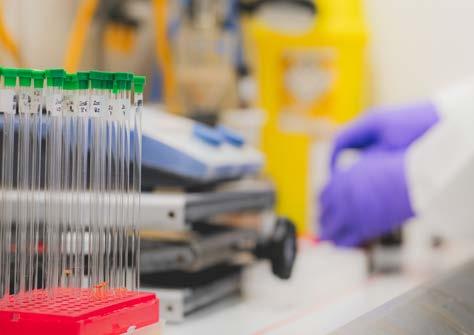
The DDU tackles unmet medical need through small molecule drug discovery, bridging the gap between academic scientific research and commercial and charitable drug discovery and development. We draw on the best of these worlds, employing highly skilled, experienced scientists from academic and pharmaceutical industry backgrounds, with a professional, pioneering approach to our work.
We have two core areas of activity
→ Anti-infectives drug discovery
→ Innovative targets and pathways
In Low- and Middle-Income Countries (LMIC), more than 3 billion people are at risk from diseases such as malaria, TB, leishmaniasis, Chagas disease, cryptosporidiosis and schistosomiasis. As well as these diseases which predominantly affect LMIC countries, COVID is still a major issue in these countries.
Existing treatments can be expensive, difficult to administer, unsafe and/or increasingly ineffective as the pathogens that underlie these conditions develop resistance. Our overall goal is to generate lead compounds suitable for further development with our partners and, ultimately, to identify candidate molecules for entry into pre-clinical and clinical development.
Disease experts and academic researchers continue to discover new biological processes which could be drug targets for major clinical indications. However, these targets are very often not sufficiently validated for licensing into pharmaceutical company portfolios or for spin-out company investment. The DDU is committed to bridging this gap by developing chemical assets that can advance our understanding of the underpinning biology and, ultimately, establish proof of concept in gold standard pre-clinical models of disease.
We collaborate with partners globally to identify potential drug targets, lead compounds, candidate drugs and novel tools and approaches to develop improved treatments for a wide range of debilitating and deadly diseases. The DDU has
→ Design, synthesis and development of drug-like compounds from hit validation and expansion through to preclinical candidate, guided by computational approaches, bioassay and drug metabolism and pharmacokinetics.
→ New synthetic design and synthesis techniques
→ Automated high-throughput chemistry
→ Flow chemistry
→ Suite of Late-stage functionalisation reactions for optimisation lead optimisation
Drug Metabolism and Pharmacokinetics
→ Industry standard in vitro and in vivo assays
→ Disease relevant in vivo models including 8HUM mouse (transgenic mice with human phase 1 metabolism)
→ Extensive use of imaging modalities with in vivo models.
→ Integrated PK/PD
→ Metabolite identification studies
→ AI and Machine Learning for virtual screening
→ AI and Machine Learning for compound design and optimisation
→ Data sciences to inform target selection
→ Design of fragment and compound libraries
→ Data management
the full repertoire of professional, industry-standard expertise and infrastructure required for early-stage drug discovery. These disciplines work together closely within an integrated management structure.
→ Target-based and phenotypic screening technologies integrated with Mode of Action studies
→ Bespoke compound libraries
→ Multiple screening modalities for primary screening and secondary assays for both target-based and phenotypic assays. This includes technologies for both lead-like and fragment libraries. Technologies developed include -enzyme assays in multiple formats, high-content imaging, RapidFire Mass Spec, SPR, NMR, ITC and the X-CHEM platform
→ Structural biology platforms including X-ray protein crystallography, cryoEM, HDX.
→ Automated plate-based synthesis methodology direct into biology and DMPK assays
→ Disease relevant screening cascades
→ Full in-house Compound Management plating and storage facilities for latch racks and microplates.
→ High throughput liquid handling robotics utilising both tip based and acoustic technologies
→ Ability to perform Cherry Picking, Library Screening, Potency curve generation, and Plate Reformatting in 96, 384 and 1536 well plate formats.
→ Manage a high quality screening library comprising of over 350,000 compounds, comprised of Diversity screening sets and Focused libraries.
→ Manage and curate libraries for the DDU and external partners, supplying certain libraries globally.
The DDU benefits from being part of the Wellcome Centre for Anti-Infectives Research (WCAIR). Wellcome funding has allowed investment to overcome the challenges the drug discovery pipeline faces. WCAIR innovation has focussed on improving 4 key areas critical to successful drug discovery:
→ Compound Design: Predicting the properties and activities of compounds before they are made, based on coherent data sets to train algorithms, and computational expertise and methods to derive them.
→ Chemistry Design and Synthesis: Improved and broader methods to rapidly and efficiently make optimally designed compounds at a scale to address key project goals.
→ Assay Design: Physiological and disease appropriate in vitro assays and animal disease models that are predictive of human clinical outcomes, where appropriate taking advantage of state of the art imaging.
→ Data Analysis: Use all available data to build better design models through machine learning.
By tackling these issues, we are impacting the whole drug discovery continuum to accelerate project progression (or closure) and thus increase the flow of candidate drugs. These improvements are available to others, through collaboration, knowledge exchange and training. Although WCAIR’s current focus is on leishmaniasis, Chagas disease, cryptosporidiosis and schistosomiasis, the ’toolbox’ of methods and approaches under development is applicable to other diseases.
Strong partnerships with organisations funding scientific research for drug discovery has been fundamental to our success. We are grateful to Wellcome, the Bill & Melinda Gates Foundation, Medicines for Malaria Venture, the Medical Research Council of UKRI, Global Health Innovative Technology (GHIT) Fund, and the Drugs for Neglected Diseases initiative, amongst others, for their continued support and encouragement. We align our research strategies and infrastructures with our funder’s aims and objectives and, together, deliver on our joint objectives to control or eliminate debilitating and fatal diseases.
Our impact is recognised not only by the progression of our compounds into pre-clinical and clinical trials with our partners but also by supporting partner academic groups to secure research grant funding to further explore disease biology using the tool molecules we produce.
Key numbers
6 compounds in clinical development
130 experienced translational scientists
9 assets licensed to pharmaceutical companies
6 new companies enabled with DDU assets
>£100m secured in research funding


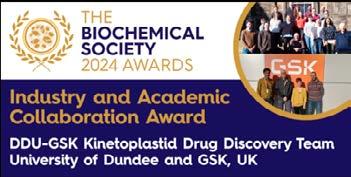


→ Industry and Academic Collaboration Award to DDU and GSK
The Biochemical Society 2024 Awards
→ Best oral presentation at the MGMS Young Modellers Forum
- Peter Ezzat Ibrahim
Awarded by Molecular Graphics and Modelling Society
→ The Morton Lecture
- Prof. Sir Mike Ferguson
The Biochemical Society 2024 Awards
→ Collaboration Award for Ali Floyd
The Dundee Difference Awards
→ Worth £14 million in forward funding
→ DNDi Project - Early drug discovery Chagas disease
DNDi Awards 2023
→ Engaged researcher of the year
- Fred Simeons
SLS Brian Cox Prize for Excellence in Public Engagement with Research
→ SLS Innovator of the Year 2023 (Research focused)
- Peter Ezzat Ibrahim School of Life Sciences Awards 2023

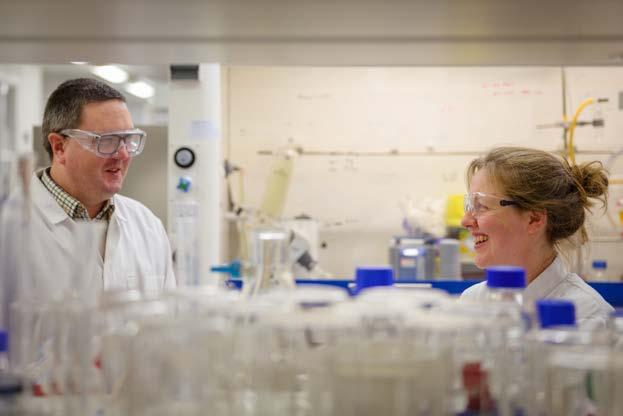
→ 17 new people joined DDU
→ 4 people moved from DDU to new jobs
→ 10 promotions
→ 14 Merit Awards
→ 23 papers published
→ 1 patent filed
→ Mentioned in 1 parliamentary debate
→ Hosted 6 trainees from LMIC
→ 141 people attended Short courses
→ >10,000 views of WCAIR Training videos on youtube
→ 2 Exhibitions with >8000 visitors
→ 50 feet of mosquito netting used
→ 15 deadly pandemics defeated through ‘Heal the World’
→ 5 Festivals
→ 1 new library-30,000 compounds
→ 1 new screening cascade for cryptococcus
→ 363 317 compounds screened in single point
→ 9403 compounds screened to give dose response curves
→ 377,913 new compounds registered
→ Produced 1.5kg pure proteins.
→ >1000 Binding assays by NMR
→ High throughput crystallography
→ >50000 crystal condition tested
→ >850 crystal tested
→ 36 unique crystal structures solved using synchrotron light source
→ 800 L E.coli cultures
→ 1 new Supercritical Fluid Chromatography machine installed
When the DDU began in 2006 its focus was on delivering pre-clinical candidates for Human African trypanosomiasis (HAT). HAT is caused by the protozoan parasites Trypanosoma brucei gambiense and Trypanosoma brucei rhodesiense and transmitted by the bite of an infected tsetse fly. The disease, fatal unless treated, has two stages: an initial peripheral infection and a second stage when parasites enter the central nervous system, causing the classic symptoms of HAT, eventually leading to coma and death. Back in the early 2000s available treatments were poor, with unacceptable efficacy and safety profiles, particularly in the second stage of the disease.
T. brucei N-Myristoyltransferase (TbNMT) was identified as potential drug target for HAT through genetic approaches by collaborators of the DDU. Following a small molecule diversity screen and subsequent optimisation programme, the DDU validated TbNMT as a good drug target in a mouse model of HAT (Nature, 2010, 464, 728-732). One of the resulting proprietary small molecule lead compounds (DDD86481) rapidly killed trypanosomes both in vitro and in vivo and cured trypanosomiasis in mice. However, DDD86481 was not blood brain barrier penetrant and therefore not a suitable candidate for taking forward to treat stage 2 HAT in humans. DDD86481 otherwise had good drug properties for a peripheral indication and given that NMT plays a role many cellular functions its potential as a target in many diseases including cancer has been greatly explored.
The DDU began a programme to reposition DDD86481 by providing the compound to collaborators with appropriate NMT-driven disease models however, the story in cancer was not straight forward and it was unclear which cancer types to target in the clinic. A serendipitous meeting between Prof David Gray at the DDU and Dr Luc Berthiaume, from the University of Alberta changed that. Luc had evidence that low NMT2 expression is highly prevalent in leukaemias and lymphomas. By targeting the remaining NMT1 enzyme in these cancers with DDD86481 the DDU and Luc showed that you could selectively kill cancer cells over healthy cells (which retained both NMTs isoforms). 19 types of cancer have the loss of one NMT at a prevalence of 5%- 80%.
Dundee licenced DDD86481 (and other related compounds) to Luc’s spin-out company, Pacylex, in 2017 where it became known as PCLX-001.
A key enabling step by Pacylex to take PCLX-001 to the clinic was the development of a companion diagnostic test to identify patients with cancers sensitive to NMT inhibition. Excitingly for the DDU, on the 22nd November 2022, Pacylex announced that PCLX-001 had been awarded Fast Track Designation for the treatment of adult patients with relapsed or refractory acute myeloid leukaemia (AML) by the FDA. On the 18th May 2023, Pacylex announced that in the expansion study, the first patient with Relapsed/Refractory Non-Hodgkin Lymphoma had been dosed in a Phase 2a Study with PCLX001 and published the results of the phase 1 trial (doi.org/10.1200/JCO.2023.41.16_suppl.e15094). 2023 ended with the publication of the Phase 1 safety and efficacy results for PCLX-001, now called Zelenirstat which showed excellent bioavailability, half-life, safety profile, and drug exposure. Zelenristat has also shown potent in vitro radiosensitization in human glioblastoma models and unexpected prolonged progression free and overall survival in colorectal and appendiceal cancers (Phase 1). Zelenirstat has also shown potent in vitro radiosensitization in human glioblastoma models.
Zelenirstat, is a first-in-class, once daily, oral cancer therapy with a novel mechanism of action and offers a potent alternative to classic therapies to kill cancer cells. In line with the Pacylex diagnostic test for sensitivity biomarkers, the company continues to generate data to support the use of Zelenirstat in other cancer indications. Now in Phase 2 trials DDD86481 has come a long way, and the DDU is thrilled that it is now treating patients with an unmet medical need.

The advent of automation and artificial intelligence (AI) in Drug Discovery means we now have the tools to generate high quality data in sufficient quantity to allow machine learning approaches to enhance our Discovery decisions. The role of the Data Management team was always to create structured data which was primarily consumed by Discovery Scientists, however modern Data Science approaches can automatically construct relationships between data to create knowledge and learning. We have started to build a Computational Drug Discovery unit at the DDU that integrates Data Management, AI and Data Science for Chemistry and Biology.
Over the summer Prof. Mike Bodkin joined the School of Life Sciences to head up Computational Drug Discovery within the DDU. Mike brings with him considerable experience in computational approaches for drug discovery gained within Pharma. He jokes his career has gone full circle starting as a synthetic chemist for Sir James Black in the early 90s before finally making it to Dundee and the DDU (partly based in the James Black Centre, School of Life Sciences). He transitioned into computational chemistry with a PhD in the crystallography department at Birkbeck College and a post-doc in the pharmacology department at Cambridge. His formative years were at AstraZeneca and Eli Lilly where he designed multiple molecules that entered the clinic. In 2014 he moved to Evotec to head up the Computer-Aided Drug Discovery and in-silico R&D departments.
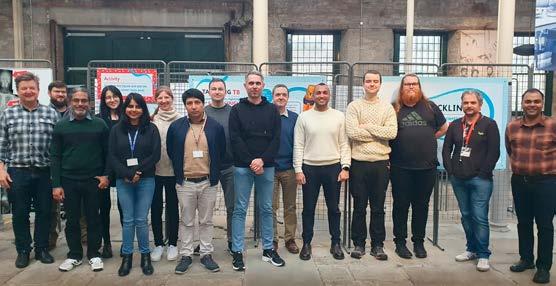
Mike’s ambition is to converge biology, chemistry and data sciences with the goal to expedite the discovery of novel therapeutics using state of the art in-silico approaches. What drew Mike to the DDU was the wealth of data combined with the significant disease knowledge. The DDU has amassed nearly 20 years of data relevant to infectious disease and discovery and together with our funding partners has established a global network of disease experts.
The creation of a data science team will integrate these disparate data sources into a knowledge repository of infectious disease to develop a greater understanding of the disease biology, selection of drug targets and to support Mode of Action studies under the umbrella of AI for biology.
We will continue to build on the progress made in AI for chemistry with the further development of generative design and reinforcement learning approaches and fully embed the techniques into discovery projects. To prepare the DDU for the future of drug discovery AI, machine learning and physics-based methods of computational drug design will be developed and implemented over the 5-year period. Funded initially by WCAIR and then from other funding sources. Implementation of these methods will occur after review by the leadership team.
The direct to biology (D2B) initiative integrates machine driven computational design, automated chemistry and compound screening (initially using mass spectrometry methods) and will move into production in 2024. The approach will form part of the hit to lead process for all portfolios, with the aim of very rapidly scoping out a compound Structure Activity Relationships (SAR) and generating predictive models to guide the Lead Optimisation phase of the project. We will develop active learning processes for compound design and optimisation; new automated methods for compound synthesis; and quantitative new mass spectrometry based approaches to assay compounds.
Data is at the heart of all activities within the DDU. DDU researchers and scientists rely on the team to provide them with a stable informatics infrastructure for data entry, retrieval and analysis. Working closely with colleagues from the University Infrastructure and Research Computing team, we maintain an industry-standard platform consisting of IDBS ActivityBase, Dotmatics and Pipeline Pilot (Biovia). More recently, we have incorporated LiveDesign (Schrodinger) into this eco-system to allow project teams to track compound information from idea to experiment and subsequent analysis and reporting of the data in a centralised platform.
It is of paramount importance that the data used to build better predictive models for compound properties and activities through machine learning, deep learning and AI is accessible and robust. In collaboration with the Computational Chemistry team, we facilitate this process and make these methods and tools available to the end users in our data workflows and compound design tools.
Across the five portfolios, we have multiple internal and external collaborators who provide data in a variety of formats. We have developed an extensive range of data workflows to convert the different source files allowing the project teams to perform comprehensive data analysis and decision-making. Using similar processes, we routinely register large (30K+) commercial and collaborator compound libraries and make these available to the project teams for screening.
We work closely with the in-house Compound Management group to provide them with the tools required to translate the information from the high-throughput liquid handling robotics. These tools are integral to Cherry Picking, Library Screening, Potency curve generation and Plate Reformatting in 96, 384 and 1536 well plate formats which can then be registered into our databases.
It is often the case that information regarding a protein of interest can be found across multiple data sources (Uniprot, clinicaltrials.gov, disgenet.org etc.) but querying them and subsequently collating the information can be timeconsuming. Working alongside colleagues in the Innovative Targets Portfolio, we have developed a tool which uses the Uniprot ID as the common key and programmed Application Programming Interface (API) calls to run queries of a range of external data sources and then collate the information into a report.
The Data Management and Infrastructure team plays a vital role in supporting research and development efforts, ensuring data accuracy, security, and compliance, and ultimately contributing to the DDU’s ability to make informed decisions and advance our research programmes. The data management team is now incorporated into the computational drug discovery team, to allow for a more seamless integration of data into our processes.

The Compound Management Team is often referred to as the beating heart of the DDU thanks to the key roll they play interacting across all our departments.
The Compound Management Team uses state of the art technology to produce assay ready plates and are the custodians of the DDU’s compound library collections. They have also been integral in the development of our high-throughput chemistry applications and will be key to implementing the direct to biology (D2B) initiative.
Through continued investment from Wellcome and the Bill & Melinda Gates Foundation the team has continued to be a focal point of quality, technical excellence, and efficiency.
Our core processes are designed around our two main dispensing technologies; two Beckman Coulter Access robotic systems with integrated Echo acoustic dispensers; and a Tecan Fluent tip based system. By utilising both contact and contactless technologies we can produce bespoke assay ready plates in any format within a range of 2.5nL – 1mL. In 2023 we upgraded one of our existing Echo 550 systems to Echo 650 through funding from the Bill & Melinda Gates Foundation and Wellcome, unlocking greater speed and accuracy of dispensing capabilities.

The DDU has a substantial inhouse compound library collection of over 350,000 compounds. This is made up of different large diversity library sets, and a few smaller, more focussed sets. In previous years the DDU has worked with both The Bill & Melinda Gates Foundation and Medicines for Malaria Venture (MMV) to create several Diversity, and Small Polar library collections to be screened through external partnering laboratories with the data being publicly shared to further research opportunities elsewhere. These were deemed so successful that The Bill & Melinda Gates Foundation have teamed up with Wellcome and the DDU again to create a new diversity set, the Global Health Chemical Diversity library v2, that is made up of bespoke compounds selected from a virtual library collection and which are not ordinarily found in commercial sets (C. Wilson et al. 2023. PLOS Neglected Tropical Diseases 17(12) e0011799). The library became active mid-2023 and the first partner screens have been selected and assay plates provided.
As well as the integration of this new library collection, the team has also begun the replating of our existing library sets into a new format. There has been a shift in how the project teams within the DDU Biology approach screening campaigns. Groups no longer wish to screen entire library sets, but rather use a computational chemistry approach to select which compounds from across our sets are most likely to produce hits in their screening assay. To adapt to this change we have leveraged our existing technologies by moving our compound collection to 1536 muti-well plates for screening to reduce the number of source plates required and created a 384 multi-well copy to allow direct cherry picking and potency plate creation on the Echo Access systems.
Scientists within the Compound Management community have long known that compounds resuspended in DMSO have had issues with the hygroscopic nature of DMSO. This water ingress into compound solutions can lead to solubility issues and concentration issues which negatively affect the reproducibility of data produced from the same library of compounds. By creating a DMSO rich atmosphere within our pod-based system we have been able to remove the water from our high value compound library plates. The moisture levels within the plates were greatly diminished by this process and the DMSO percentage was back up near the original starting point of 95%. This allows us to now improve our reproducibility of compounds by negating the negative effects of the dilution of the stock solution and also the solubility issues that water ingress can cause. This work was presented via poster at ELRIG Liverpool 2023.
Along with the regular functions associated with the compound management team, we have also expanded the scope of our roll by training members of staff in running QC analysis using LC-MS. This technique has been used to run a quality assessment on the new compound library this year by the team and will become a more regular activity going forwards as we remake our existing library plates.
The team also participated in the WCAIR training programme by hosting a scientist from the Brazilian Bioscience National Laboratory. The individual required training and assistance in setting up a new compound management laboratory so they came to see how our entire process worked, and to be trained in the instrumentation they will be installing. The team was able to send them away with a lot of handy tips and readymade protocols to get them started.
The kinetoplastid portfolio aims to develop much needed new medicines for Chagas disease. Chagas disease is a chronic disease that results from infection with Trypanosoma cruzi protozoan parasites. It affects millions of people in Latin America and beyond, and is a major cause of debilitating, and sometimes deadly, heart disease.
Portfolio overview
Our work in Chagas disease ranges from basic biology to pre-candidate selection. Main areas of activity are:
→ Study of persister parasites. Parasites that are less susceptible to drug treatment are a key challenge in Chagas disease drug discovery. A key goal is to develop higher throughput assays to assess the activity of new compounds against persisters.
→ New methodologies to improve the drug discovery path for Chagas disease: a major aim is to better understand the compound profiles required for Chagas drugs, this
→ The Biochemical Society “Industry and Academic Collaboration Award” for our highly successful collaboration with GSK. We started working with the GSK Global Health Kinetoplastid group in 2011, and have since then delivered two clinical candidates for visceral leishmaniasis, and built a strong portfolio for new Chagas disease treatments.
→ DNDi Project of Year: Early Drug Discovery for Chagas disease. We were co-recipients of this award for our contributions to hit discovery and hit profiling in Chagas disease.
includes the in vitro profile, mode-of-action, and in vivo understanding of PK/PD drivers.
→ New modalities: we are exploring how to enable targeted protein degradation approaches for kinetoplastid diseases.
We use a science-directed approach to achieve this, often through development and implementation of new methods and approaches.
→ The 4WAY001 series is our most advanced series, which shows clinical level efficacy in an animal model of chronic Chagas disease and we are working towards identifying a pre-clinical candidate in this series. This project is being conducted in collaboration with GSK, DNDi and the University of Washington. We have also identified multiple other series that act through the same promising mode-ofaction which provide backup for 4WAY001.
→ For our TCT02 series we have obtained initial proof of concept data and the series is now very close to entering lead optimisation.

Key publication:
→ Thomas MG et al. Structure-Guided Design and Synthesis of a Pyridazinone Series of Trypanosoma cruzi Proteasome Inhibitors. J Med Chem. 2023 Aug 10;66(15):10413-10431. doi: 10.1021/acs.jmedchem.3c00582.
In this paper we describe the development of a new series of T. cruzi proteasome inhibitors guided by cryo-electron microscopy and AI-based approaches.
Visceral leishmaniasis - GSK899/DDU651
Visceral leishmaniasis – GSK245/DDU143
Chagas disease – 4WAY001
Chagas disease – 4WAYbackups
Chagas disease- multiple series
Funders and Consortia


In 2023 we started a small programme, funded by the Tres Cantos Open Lab Foundation, to develop phenotypic screening assays for Crypcococcus neoformans. C. neoformans causes cryptococcal meningitis, which has high rates of mortality in immunocompromised people in sub-Saharan Africa. The current treatments have significant drawbacks, and our long-term goal is to develop better drugs, developed specifically for Cryptococcus.
Funders and Collaborators TCOLF (Tres Cantos Open Lab Foundation)
HIT-NTD Chagas disease meeting
→ In May 2023 we organised a three-day meeting in New York City bringing together key groups working in Chagas disease drug discovery to share knowledge and progress in our programmes and to discuss the drug discovery path for Chagas disease.
We set up a new laboratory to carry our Cryptococcus experiments.
→ We developed a high-throughput screening assay to identify fungicidal compounds and identified initial hits.
→ We started the development of a series of secondary assays to assess compound efficacy against many clinically relevant morphotypes.
Aims to develop new medicines for three parasitic infectious diseases that cause considerable health impact in low- and middle-income countries : malaria, cryptosporidiosis, and schistosomiasis.
In 2021 there were approximately 247 million cases of malaria and 619,000 deaths. The reduction in malaria has stalled and resistance to the current standard of care is rising in South East Asia and Africa. New treatments are urgently needed to overcome this threat. Cryptosporidium is one of five most important diarrhoeal pathogens in infants under 2 years of age. Cryptosporidiosis causes severe diarrhoea in very young or malnourished children and HIV patients, and frequently leads to death, or stunting and delayed cognitive development in survivors. There is currently no targeted effective treatment for cryptosporidiosis. An effective treatment for cryptosporidiosis could save lives of hundreds of thousands of infants and children and improve their development.
Schistosomiasis is a disease caused by parasitic nematodes. People are infected when exposed to infested water and school-aged children are especially vulnerable to infection. Chronic infections can lead to liver damage, kidney failure, infertility and bladder cancer. WHO estimates that at least 236 million people required preventive treatment for schistosomiasis in 2019. Praziquantel is the only drug approved for this disease and it is used both for treatment and
→ We published a perspective on Schistosomiasis Drug Discovery with the highlights from the workshop we organized in September 2022 (doi.org/10.1021/ acsinfecdis.3c00081).
→ The ACS1 series progressed this year to lead optimisation with funding from MRC-DPFS in collaboration with Prof. David Fidock (Columbia University) and with scientific advisory support from MMV.
→ Our cryptosporidiosis leads discovered in collaboration with Prof. Chris Huston (University of Vermont) and Eisai are being profiled towards candidate selection.
mass drug administration campaigns. There is a pressing need for new and more effective medicines to treat schistosomiasis.
Portfolio overview
Our projects cover hit identification to preclinical candidate selection.
→ Our schistosomiasis project, a collaboration with Prof. Karl Hoffman (Aberystwyth University) and Prof. Andrea Brancale and Prof. Andrew Westwell (Cardiff University) is focused on refining the drug discovery pathway for schistosomiasis with funding from Wellcome.
→ As members of the Malaria Drug Accelerator (MalDA), we collaborate with leading academic and industry partners to identify and exploit novel mechanisms of actions for antimalarial treatments.
→ We lead the Structure Drug Discovery Coalition (SDDC). The SDDC aims to apply structure-based drug design to deliver inhibitors for novel validated targets with proof-of-concept in vivo efficacy for malaria and TB with funding from Bill & Melinda Gates Foundation. Our SDDC partners are Seattle Structural Genomics Center for Infectious Disease (SSGID), Center for Structural Biology of Infectious Diseases (CSBID) and Prof. Couñago (University of Campinas).
→ Compounds series developed by the SDDC for malaria or TB are further optimized by the DDU malaria or TB teams towards candidate selection.
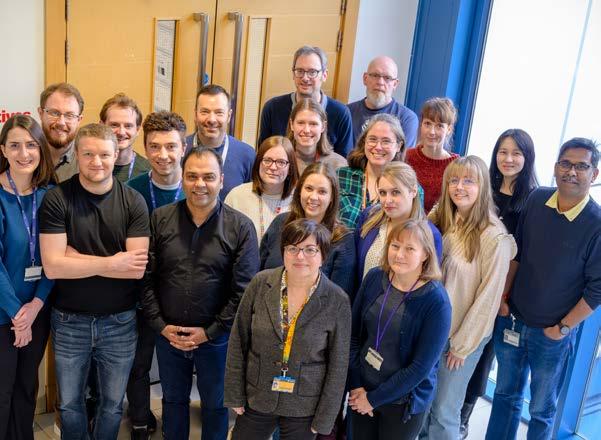
“It is a huge source of personal motivation for me to be part of something that could have a positive impact on human health. The Malaria programme I am working on has rare activity against a particular life stage of the parasite, which makes it super exciting for development. To move a drug discovery programme like this forward requires a multi-disciplinary team with a range of skill sets. This means every day is a school day and I am constantly learning from my colleagues, no two days are the same and I love that!”
Kate, Medicinal Chemistry Team Leader
“Having recently joined the Apicomplexan portfolio I have been pleased to see that the team is very engaging and open to suggestions in how we tackle our goals as a group. Being a biologist at the DDU is a great opportunity as it implements leading industry style work practices but also enables you to continuously develop your own academic professional development. On one hand you are exposed to expert knowledge regarding a variety of disease areas and drug discovery approaches within the DDU itself, and then furthermore, are encouraged to engage with biology outside of your field through wider colleagues at the School of Life Sciences. A great place to grow as a scientist!”
John, Biologist
Malaria- Cabamiquine
Cryptosporidiosis - KRS
Malaria- Pf AcAS
Malaria- Pf IleRS
Schistosomiasis phenotypic series
Funders and consortia




We are all familiar with the Covid-19 pandemic, caused by the coronavirus Severe Acute Respiratory Virus 2 (SARS-CoV-2).
For many people in clinically vulnerable groups, especially those unable to be vaccinated, the concern of being infected with circulating SARS-CoV-2 virus still remains. For these groups, the development of novel antiviral drugs against SARS-CoV-2 is important, particularly as mutations in viruses can confer resistance to current therapies over time. In addition, although the threat to wider society appears to have mostly passed, it is worth reflecting that the SARS-CoV-2 virus is only one of a whole family of coronaviruses that widely infect both animals and birds in the wild. Seven coronaviruses are known so far to infect humans; SARS-CoV, MERS, OC43, NL64, HKU1, 299E, and SARS-CoV-2 and the prospect of another coronavirus emerging from an animal coronavirus remains likely.
To many experts, the prospect of a novel coronavirus emerging again is a question of when, not if. The Coronavirus Portfolio therefore is positioning itself towards “Pandemic preparedness”. In the event of another coronavirus outbreak, we would have chemical compounds “on the shelf” ready for tailored development to the novel coronavirus, or ideally, a pan-coronavirus compound already in hand to be rolled out.
The Coronavirus portfolio works within the CARE (Corona Accelerated R&D in Europe) consortium, with funding from the Bill & Melinda Gates Foundation. Our current focus is on the methyltransferase activity of Nsp14, a dual domain protein involved in RNA processing and RNA CAP formation. The active site of nsp14 is highly conserved across several genera of coronaviruses, making it an attractive potential target for pan-coronavirus activity. In addition to development of our lead series, we have completed several screening campaigns, which have read-out some promising new chemical starting points. Our lead series and new backup series are being profiled in biochemical assays against nsp14 proteins from across the coronavirus family to identify opportunities for pan-coronavirus activity. Currently we are progressing our lead series into a Proof of Concept experiments with our collaborators in CARE.
Renewal of BMGF grant to progress Nsp14 lead series into preclinical toxicology and develop strong backup series with broad coronavirus activity
→ Completion of further screening activities and identification of promising new starting points
→ Several new crystal structures solved, including a new novel mode of inhibition

“Within the CARE consortium, I have worked closely with the COVID portfolio team at Dundee over the last 12 months to set up proof-of-concept animal experiments. They are easy to work with and I have found the collaboration interesting and fruitful.”
Dr Sebenzile Myeni, Senior Researcher, Leiden University Medical Centre
“Having previous experience in academic and pharmaceutical labs it is easy to see the benefits of an institution like the DDU, situated in an exceptional Life Sciences environment. There is a willingness to share knowledge and experience coupled with cutting edge technology and innovative techniques which makes every day different, challenging and rewarding. Our COVID portfolio is a prime example of great teamwork with many collaborations both internal and international.”
Sandra, Biologist, DDU
“I feel grateful to work with such a talented group of scientists in the thriving environment of the DDU. The Coronavirus scientists’ drive and hard work makes working on difficult and important problems an exciting and collaborative experience”
Duncan, Coronavirus Portfolio leader, DDU
Nsp14- lead series
Nsp14- lead backups
Nsp14- new screens
Funders and consortia
The Tuberculosis (TB) team aims to identify new drug candidates for progression towards clinical studies. We are focussed on identifying compounds acting on novel modes of action to compliment the therapies that already exist and which, offer new potential in the treatment of the disease. Multi- and extensively- drug resistant strains of TB continue to increase, so there is an urgent need to discover new drugs to overcome resistance to the front-line therapies. By targeting novel modes of action, the aim is that pre-existing clinical resistance will be reduced or non-existent. TB remains a huge global issue. An estimated 10.6 million people developed TB in 2022, and 1.3 million people died from the disease (WHO Annual Report 2023). As a member of the Tuberculosis Drug Accelerator (TBDA) and European regime accelerator for new TB treatments (ERA4TB) we work with numerous academic and commercial partners across the globe to work towards achieving our goals.
“Human tuberculosis (TB) is caused by the bacterium Mycobacterium tuberculosis. Unfortunately, treatment of even uncomplicated, drug-susceptible TB is lengthy, requiring 6-9 months of therapy using a 40-year-old four drug regimen for which extensive clinical drug-resistance exists. There is clearly an urgent medical need for new, more effective human TB treatments.
To address this challenge, the drug discovery field has focused on radically shortening the course of treatment. The team at the DDU has proven instrumental towards achieving this goal, by identifying new ways to target bacteria resistant to current drug regimens, and discovering new drugs that can lead to accelerated treatment regimens for tuberculosis.”
Greg Robertson, Colorado State University
Portfolio overview
Our efforts on TB range from hit discovery through to preclinical candidate selection. Our main areas of activity are:
→ Phenotypic screening of compound libraries against TB (more than one million compounds screened to date) through collaboration with NIAID.
→ Progressing screening hits through to pre-clinical development.
→ Working with partners across the TBDA to identify targets of phenotypic screening.
→ Target based projects focussing on high value, novel targets with the aim of avoiding pre-existing resistance.
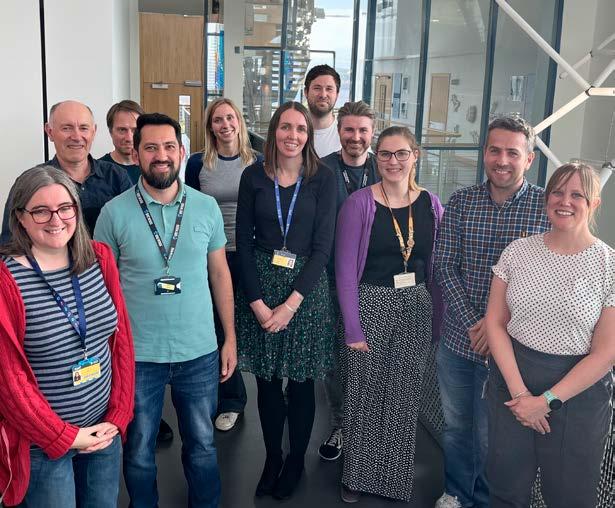
→ New award from the Bill & Melinda Gates foundation Designed “Assessing Start Points for Eradicating Clinical Tuberculosis” (ASPECT) kicked-off in March 2023.
→ Our late-stage LO series V46 series 1 was transitioned to pre-clinical selection phase.
→ Our work on a new Pks13 series was published doi.org/10.1021/acs.jmedchem.3c01514
→ Follow up on hits identified from phenotypic screening of a large 140,000 compound library continued.
→ Collaboration initiated with a new industrial partner.
→ Target pathways identified for two phenotypic hits.
→ 6-month public engagement event launched ‘Tackling TB’ in partnership with WCAIR, Verdant Works and Dundee Heritage.
“The TB team is part of a multi-collaborative, fast-paced environment to help accelerate the cure for TB and save millions of lives. As scientists, we have the chance to translate the DDU expertise (production of small molecules as potential new antibiotics) into exciting new mechanistic pharmacology. Through global partnerships with academic and industry collaborators, we have access to a range of cutting-edge technologies to deconvolute the underpinning biology of our compounds and their safety window. All this knowledge generated is then iteratively leveraged to improve existing compounds and hopefully achieve the next generation of antibiotics.”
Fabio, Biologist“Since moving to the [TB] Team in July, I have really enjoyed being exposed to the different aspects of the drug discovery portfolio, from H2L through to LO. It’s also been great seeing our work put in context for a wider audience through the collaboration with the Verdant Works, and makes explaining what I do for a living much easier to nonscientists!”
Jamie, Medicinal ChemistV46 series 1: Phenotypic series
LysS series 2
V46 series 1: Phenotypic series
Phenotypic series 1
Phenotypic series 2
Pks13 series2
DEL1 Pks13 series
Multiple Early Phenotypic series
Funders and consortia

Most academic research into disease biology is insufficiently validated for direct incorporation into pharmaceutical company pipelines. Consequently, an enormous amount of scientific research in UK universities fails be translated into public health benefit. Our innovative targets portfolio (ITP) seeks to address this gap by translating academic research and novel drug targets into licensable data packages suitable to attract follow-on investment. ITP sources innovative biology from leading investigators across the UK and beyond and forms active research collaborations and translational plans to validate novel targets with small molecule drug discovery. Data packages including novel chemical assets showing proof of concept in cell or tissue models are partnered with the BioPharma industry for onward development.
Translation of research excellence into tangible public benefit is at the heart of the University strategy and is evidenced by the impact from the ITP. We continue to deliver a strong pipeline of commercialisation opportunities and sustainable partnerships with industry.
Given the nature of innovative target drug discovery, this group within the DDU is exposed to many different types of disease biology and collaborations with both academia and industry.
Portfolio overview
We continue our work with biotech companies (Beactica) and large pharma and acknowledge the key insights and world leading expertise that our academic collaborators from Dundee, Queen Mary University of London and Cambridge bring to our innovative targets portfolio. We are actively driving our commercialisation endeavours with the aim to launch either a new company or licence assets to pharma with multiple projects going through due diligence review in 2023.
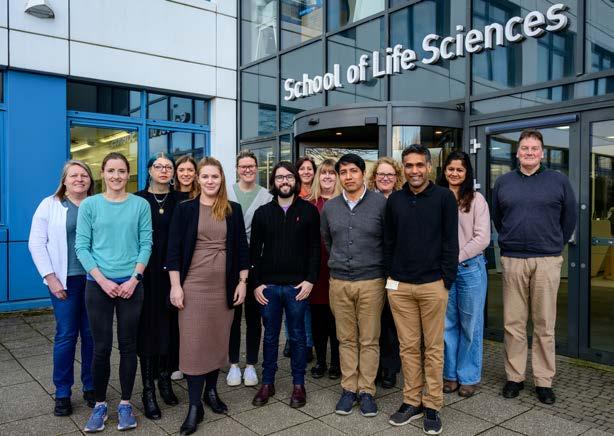
→ 2023 was an exciting year with one of our licenced projects entering phase 1 clinical trials for the treatment of non-Hodgkins lymphoma and advanced solid tumours via Pacylex (www.pacylex.com).
The first patient treated with PCLX-001 (formerly DDD86481) was reported in March 2022 (doi: 10.3390/ curroncol29030158 ) with trials continuing. In January 2023 PCLX-001 (now Zelenristat) was granted Fast Track Designation for the treatment of adult patients with relapsed or refractory acute myeloid leukaemia (AML) based on the results from non-clinical studies and the ongoing non-Hodgkins lymphoma trials.
→ We were part of a successful application for a Horizon Synergy award to explore the fundamental control of alternative RNA splicing. This �10 million, 6 year award is in collaboration with colleagues in Dundee, Barcelona and Munich.
→ 3 oncology projects have been through due diligence with 2 separate biotechs: 1 project went into evaluation with a biotech creation studio with results anticipated early 2024. A second oncology project will enter evaluation with a drug development company in early 2024.
→ 2 other ITP projects are in due diligence with feedback anticipated early in 2024.
“The implementation of WAC-MS as a novel screening technique non based on the equilibrium protein-ligand open up the potential for targeting weak or transient interactions that are abundant in biological systems and play major roles in complex biological networks but which are often blurred by the surrounding plethora of other interactions”
Pierre, Structural Biologist
“As a mass spec specialist, I feel my skills are particularly well-suited to the position that I am in. Developing new mass spectrometry highthroughput assays to significantly accelerate the process of drug discovery in the DDU is challenging but very satisfying. I also enjoy working in the DDU because of my amazing colleagues, who are very friendly and supportive.”
De, Mass Spectrometry expertOncology - Zelenristat (Pacylex)
Alzheimer’s disease
Gut Motility
Oncology – target 1
Oncology – target 2
Metabolism
Funders and consortia

Globally, an estimated 257 million women who want to avoid pregnancy are currently not using safe, modern and effective methods of contraception. In the period covering 20152019, nearly half of all pregnancies, totalling 121 million each year, were unintended, with higher proportions observed in low- and middle-income countries. In that same period over 60% of these unintended pregnancies ended in termination, equating to 73 million per year. The number of unintended pregnancies ending in termination was broadly similar worldwide, irrespective of legality, which means that when access to safe and legal terminations is restricted, it increases the number of women resorting to unsafe terminations. As a result, an estimated 45% of all terminations worldwide are unsafe, which can cause a variety of complications and are responsible for 5 – 13% of all maternal deaths. We believe that increasing the contraceptive options available can help to reduce the number of unsafe terminations and, therefore, the number of maternal deaths.
Whilst contraceptives currently exist, many of the options to date are not suitable for everyone. For example, female contraceptive pills are currently all hormone based and many are not suitable for smokers over the age of 35 or women with co-morbidities, such as obesity or high blood pressure. Also, as these drugs affect the hormonal balance, they can have multiple side effects that are far from ideal.
→ Secured funding from Bill & Melinda Gates Foundation of $4.4 million over 3 years to continue our promising research.
→ Significant improvements in potency for our lead series, without sacrificing our excellent DMPK properties.
→ New phenotypic assays developed by NPSC that target different sperm functions, with high throughput screening due to start shortly.
The Non-Hormonal Contraceptive Project at the DDU, funded by the Bill & Melinda Gates Foundation focuses on discovering new non-hormonal contraceptives to give more options that do not cause hormone related side effects, reduce the number of unintended pregnancies and therefore reduce the number of unsafe terminations. Working in collaboration with the National Phenotypic Screening Centre (NPSC), which is part of the School of Life Sciences, and the Reproductive Medicine Group, from the School of Medicine, we are dedicated to addressing the need for more and better contraceptive options.
Our non-hormonal contraceptive research is focused on small molecules that work via disrupting the function of sperm cells. Our current chemical series, in Lead Optimisation, is proving effective in vitro by reducing motility, which prevents the sperm cells progressing through the female reproductive tract. Not only is our lead compound showing good in vitro efficacy, it also has promising DMPK properties that are being further optimised. While working on our lead series, additional phenotypic screening is planned, with the aim to identify new hits targeting alternative sperms functions to increase the chance of success.
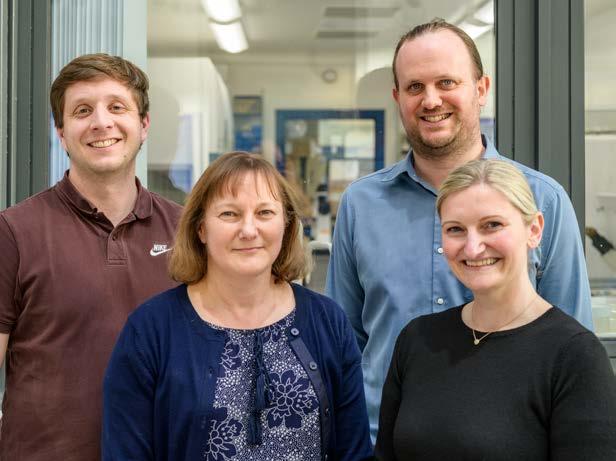
“The Non-Hormonal Contraceptive Project has been absolutely fascinating to work on and I have learned a lot about reproductive biology, and how much is still unknown about such a fundamental aspect of human life, from our School of Medicine colleagues. At the Bill & Melinda Gates Foundation Non-Hormonal Contraception meeting at Cornell University earlier this year, I had the opportunity to present our lead series and the milestones we have achieved across the project. As a result of this meeting and how promising the project looks, new collaboration opportunities are now being explored.”
Anthony, Medicinal Chemistry Team Leader
“Working on the contraceptive project over the past year has been an enjoyable, and eye opening, experience. Unlike the other portfolios, contraception is something which most adults have firsthand experience with and can directly relate to. It’s also a topic which people have very strong opinions about, and it’s fascinating to hear the varying points of view on the subject! I’m really proud of what we’ve achieved over the past year and excited to see what next year holds for us.”
Suzanne, DMPK Scientist
“The Non-Hormonal Contraceptive Project is an interesting and important research field that could have the ability to effect choices for both men and women worldwide. This project fuses medicinal chemistry, biological studies, phenotypic screening, and cross-discipline expertise from Professors and Staff members alike. New idea development towards creating future molecules that one day may arise as a new contraceptive option, for men or women, is one of my favourite things on the project. On a personal level, this project is extremely rewarding.”
David, Medicinal Chemist
MCP09: Phenotypic series
Funders and consortia


Museum exhibitions are one of the classic ways of engaging scientists and the public. They offer a fantastic way of bringing complex conversations out of the lab and into places people can safely explore. Following our experience with the National Museum of Scotland and Parasites: Battle for Survival in 2019, we were keen to develop another exhibition – this time, focusing closer to home in Dundee.
Dundee has a fantastic range of Museums. As well as the relatively new V&A, we have well-established organisations such as McManus Gallery and Dundee Heritage Trust, who run RRS Discovery and Verdant Works, Dundee’s mill museum. Following the advice of our Centre Public Engagement Advisory Board, we reached out to Dundee Heritage Trust –who were intrigued, but unsure how science might work with industrial buildings.
Through a series of workshops with scientists, curators, and museum volunteers, one theme jumped out. It neatly linked our science and the people who lived and worked in the mills –Tuberculosis.
Once we realised this, the team from Verdant immediately engaged with the idea, collecting huge quantities of information from across the city and beyond. At the same
time, our scientists gave their time to speak with the curatorial team about our research, and brought in their clinician contacts. Ultimately, we have been able to include the voices of a medic from Malawi and a local TB patient, who brought his story of illness and recovery to life.
One key feature of the exhibition is interactivity, which we deemed essential to engage Verdant’s family audience. Developing these to be both fun and scientifically accurate was one of the most interesting challenges.
A great example is the redevelopment of an old DDU game from around 2014 – Drug Discovery Snakes and Ladders. While this game captured a lot of the genuine frustration of the process, it was perhaps too hard to be a genuinely fun experience for most who played the original version. Thanks to our team’s expertise, we converted a confusing poster to a fun, accurate, and beautiful rug. This striking piece of design invites players to play, bringing the space to life for children of all ages.


The exhibition opened in early October, and will run all the way through to April of 2024. We are thrilled by the response so far, with visitors ranging from our Primary 6 class-in-residence to the Lord Provost of Dundee, who has invited us to a civic reception. The number and range of conversations the show has sparked has far exceeded our expectations. The exhibition has featured in both print and TV news, and Dundee Heritage Trust are excited to work with the University on future projects, always the sign of a highly successful collaboration. We are looking forward to finding even more ways to share our work and the exhibition, as well as continuing our fight to tackle TB.
For the creation of ‘Tackling TB’ the Tuberculosis team, supported by Public Engagement professionals Ali Floyd and Ailsa Mackintosh, were highly commended in the team category of the School of Life Sciences Brian Cox Prize for Excellence in Public Engagement with Research.
The exhibition was funded by Wellcome through the Wellcome Centre for Anti-Infectives Research.

During 2023 two compounds from the DDU have graduated into phase 2 clinical studies, which is very exciting. Merck KGaA have progressed cabamaquine (known to us as DDD107498) into trials for malaria in Africa as a combination with pyronaridine (NCT05689047). Pacylex have taken zelenirstat into phase 2a trials for B-Cell non-Hodgkin lymphoma and received FDA orphan drug and fast track designations for acute myeloid leukaemia (www.pacylex.com).
Internally, all the disease portfolios and technical disciplines continue to make good progress, as is described in this report. A new initiative we have started is to bring together in an integrated way our computational design, our automated synthetic chemistry and our bio-assay. We have named this initiative D2B (Direct to Biology). The aim of D2B to help us profile targets rapidly and to speed up our design-make-testanalyse cycle, ultimately identifying better quality candidates. This will be a major focus over the next 18-24 months, to get this established and rolled out into our drug discovery projects.
We have had success with various funding applications, include renewal of the Coronavirus grant and the nonhormonal contraceptive programme, the latter a collaboration with the National Phenotypic Screening Centre and the School of Medicine. The funding for the Wellcome Centre for AntiInfectives Research has also been extended until March 2025. Kevin Read has been spearheading the application of a new mouse model, with a humanised phase 1 metabolic apparatus, for better prediction of human pharmacokinetics and for use in efficacy model. This has led to funding from the Bill & Melinda Gates Foundation and the Tres Cantos Open Lab Foundation.
In June, we welcomed Mike Bodkin as Head of Computational Drug Discovery. He brings a new perspective to the DDU and is bringing lots of new ideas, both for computational drug discovery, as well as for the whole DDU. As we go to press, we also have a new Head of Chemistry, Mahmood Ahmed, who arrived in January 2024. He too is bringing lots of new ideas. There have been well-deserved promotions for a number of people within the DDU: Manu De Rycker and Beatriz Baragaña have both been made Principal Investigators. Denise Pryde and Alex Brown, who work in the NMR and LCMS have taken on new responsibilities and increased contribution to projects,
leading to both of them being promoted, along with Jade Siggens who has several roles within the chemistry team. Kashish and Edan from our data management team have been promoted as well in recognition for the responsibility they have supporting all DDU activities. Kate McGonagle moved into the apicomplexan team and subsequently was promoted to a team leader position.
This year has also been a good year for publications. These are listed separately in the report, and are a great marker of the scientific progress that we have made. Of particular note is a Nature Communications publication on a lysyl inhibitor as a potential compound for tuberculosis and at the end of the year, back-to-back publications in Science Translational Medicine on a short-course combination treatment in an experimental model of Chagas disease and a preclinical candidate for visceral leishmaniasis, that acts through the cytochrome bc1 complex. These are all part of international consortia.
It has been great to welcome many visitors to the DDU during the course of the year. Members of the All Party Parliamentary Group on malaria and neglected infectious diseases spent a day with us in September. The group included Catherine West and Lord Trees (joint chairs), Wendy Chamberlin, MP for Fife and Martha Varney from Malaria No More. By coincidence, Prof Linda Amoah from the University of Ghana was in Dundee at the time of the visit and was able to meet with the group and talk about the development of the drug discovery hub in Ghana, which we have been supporting. This was very well received. I was also able to meet with the Foreign Secretary James Cleverly whilst I was in Ghana in August and to explain something of the collaboration we have with the hub in Ghana. Gratifyingly, he gave a good mention to this interaction in a speech he gave.
We have continued to drive community discussion and interaction. Manu De Rycker organised a very useful meeting on drug discovery for Chagas disease in New York with other groups funded through Wellcome’s HIT-NTD Flagship. We also organised a brainstorming meeting in London with about 35 people, with a variety of different expertise, to think about how we do antibacterial drug discovery as a community.
We have also been thinking about the culture within DDU. We have a fantastic group of scientists within the DDU and we are working to make the work-environment even more stimulating and rewarding.
I am really grateful for the hard work and commitment of the very talented group of scientists within the DDU. They are operating at a very high level and deliver top quality science, which is critical to drive the drug discovery. This has been recognised through a number of external awards received in 2023 to both teams and individuals.
→ The Biochemical Society “Industry and Academic Collaboration Award” for The Kinetoplatsid team’s highly successful collaboration with GSK.
→ DNDi Project of Year: Early Drug Discovery for Chagas disease.
→ The Biochemical Society 2024 Awards: The Morton Lecture- Prof Sir Michael Fergusson
→ 1st prize for the best oral presentation at the MGMS Young Modellers Forum and Winner SLS Innovator of the Year (Research Focused) 2023- Peter Ezzat
→ The Dundee Difference Awards: Collaboration Award for Ali Floyd
→ SLS Brian Cox Prize-Engaged researcher of the yearFred Simeons
We also very much appreciate and value the help and guidance that we get from our various scientific advisory committees and scientific advisors. This coming year, we are continuing to drive towards new candidate molecules and working to address the gaps that there are in medicines to treat the disease areas that we are working on.
We acknowledge and value our many partners and collaborators across academia, industry, funding agencies and product development partnerships. These are all critical to the work that we do, and we really enjoy working with them.
 Professor Ian Gilbert Head of the
Professor Ian Gilbert Head of the
DDU
The DDU Executive Team brings extensive industry experience to the Unit and has secured over £100M in translational funding since it was established in 2006. We share a drive and determination to improve the translation of academic research by working on novel, often unprecedented, targets and applying industry-standard processes and decision making. This has helped to make the DDU a partner of choice for pharma, funders and academic partners alike.
The DDU Executive are joined at monthly meetings by additional leaders from within the DDU selected from our portfolio and discipline leaders to form the DDU Leadership team. These extra voices provide important viewpoints and experience from across the DDU and work closely with the DDU Executive at a strategic level.
Head of DDU
Ian Gilbert
DDU Executive
Head of Biology & ITG Portfolio Lead
David Gray
Head of Chemistry
Head of DMPK
Head of Computational Drug Discovery
Head of Translational Parasitology & Kinetoplastoid Portfolio Lead
Apicomplexan Portfolio Lead
Mahmood Ahmed
Extended Leadership Team
Laura Cleghorn
TB Portfolio Lead
Kevin Read
Mike Bodkin
Manu De Rycker
Beatriz Baragaña
Head of Business Development
Charlotte Green
Duncan Scott
COVID Portfolio Lead
Gary Tarver
Head of Synthetic Methodologies
Vincent Postis
Head of Molecular Interactions
Susan Wyllie
Head of Mode of Action
You can read about the DDU leadership team on the DDU website, drugdiscovery.dundee.ac.uk/about/people
WCAIR Manager
Catharine Goddard
We are very grateful to the people who devote time to working on our scientific advisory boards. They provide us invaluable advice and help.
The kinetoplastid SAC function is to analyse and provide advice regarding drug targets, prioritisation and progression of projects, and development of lead series. It comprises independent advisers with expertise in the fields of drug discovery, medicinal chemistry, anti-microbial therapy and clinical trials in addition to representatives of Wellcome. This SAC meets twice annually.
→ Graeme Bilbe (Chair), Senior Advisor, formerly Chief Scientific Officer, Research and Development Director DNDi
→ Jeremy Burrows, VP, Head of Discovery, MMV
→ Laurent Fraisse, Research and Development Director, DNDi
→ John Kelly, Professor of Molecular Biology, Department of Infection Biology, London School of Hygiene and Tropical Medicine
→ Paul Leeson, Director, Paul Leeson Consulting Ltd
→ Karine Malagu, Group Leader, Medicinal Chemistry, Charles River, U.K.
→ Maria Jesus Pinazo, Head of Chagas disease, DNDi
The Tuberculosis SAC meets annually and comprises expert advisers from the field including representatives from the Gates Foundation and TBDA. The purpose of the SAC is to advise and analyse the progression of hit and lead series.
→ Peter Warner, Senior Program Officer, Bill & Melinda Gates Foundation
→ Valerie Mizrahi, Director, Institute of Infectious Disease and Molecular Medicine, UCT
→ Nader Fotouhi, Chief Scientific Officer, TB Alliance
→ Anna Upton, Senior Vice President, Head of Tuberculosis Research and Development, Evotec
→ Robert Bates, Director, Head of TB Discovery, GSK
→ Robert Jacobs, Pharma Consultant
→ Steve Berthel, TBDA Medicinal Chemistry Lead and Program Manager
Our schistosomiasis project is supported by two external advisors:
→ Tim Wells, CSO, Medicines for Malaria Venture
→ Trevor Perrior, Scientific Consultant
The MRC DPFS funded project is a collaboration with David Fidock at Columbia University and we are supported by two external advisors:
→ James Duffy, Director MMV
→ Prof. Simon Ward, Cardiff University, MMV ESAC member and review by MMV ESAC annually
Our MMV funded projects are supported by:
→ Paul Willis, Interim Head of Discovery, MMV
→ Dennis Smith, Consultant, MMV ESAC
→ Roger Bonnert, Consultant, MMV
→ Susan Boyd, Consultant. MMV and review by MMV ESAC annually
The SDDC SAC meets bi-annually and includes representation from MalDA, TBDA , MMV, TB Alliance and BMGF:
→ Prof. Elizabeth Winzeler, UC San Diego and MalDA Program Director
→ Prof. Jim Sacchettini, TAMU and TBDA member
→ Dr. James Duffy, Director, MMV
→ Chris Cooper, Senior Director, TB Alliance
→ Gang Liu, Senior Program Officer, BMGF
Our ITP SAB support the selection and progression of innovative target proposals and projects. It comprises a number of highly regarded internal and external drug discovery experts. The SAB meets twice a year, with applications needing a quicker response being reviewed electronically in the interim.
→ Mike Ferguson, Regius Professor of Life Sciences, University of Dundee
→ Mike Ashford, Professor of Neuroscience, University of Dundee
→ Robin Carr, CEO MYRICX Pharma
→ Heather Giles, CEO, CSO and Director Vapogenix Inc.
→ Neil Thompson, CSO Healx
→ Paul Leeson, Director, Paul Leeson Consulting Ltd
Wellcome Centre for Anti-Infectives Research SAC
WCAIR SAC includes expert advisers in the fields of drug metabolism and pharmacokinetics, medicinal chemistry, antiinfectives drug discovery, toxicology and clinical trials. This international group meets once per year in Dundee. The SAC has a consultative function, advising both the host institute (UoD) and funder (Wellcome).
→ Graeme Bilbe (Chair), Senior Advisor, formerly Chief Scientific Officer, Research and Development Director DNDi
→ Mike Blackman, Professor of Molecular Parasitology, Francis Crick Institute
→ John Kelly, Professor of Molecular Biology, Department of Infection Biology, London School of Hygiene and Tropical Medicine
→ Paul Leeson, Director, Paul Leeson Consulting Ltd
→ Julian Rayner, Professor of Cell Biology, Cambridge Institute for Medical Research and Dept. Clinical biochemistry, University of Cambridge
→ Isabela Ribeiro, Head, Dynamic Portfolio Unit, DNDi
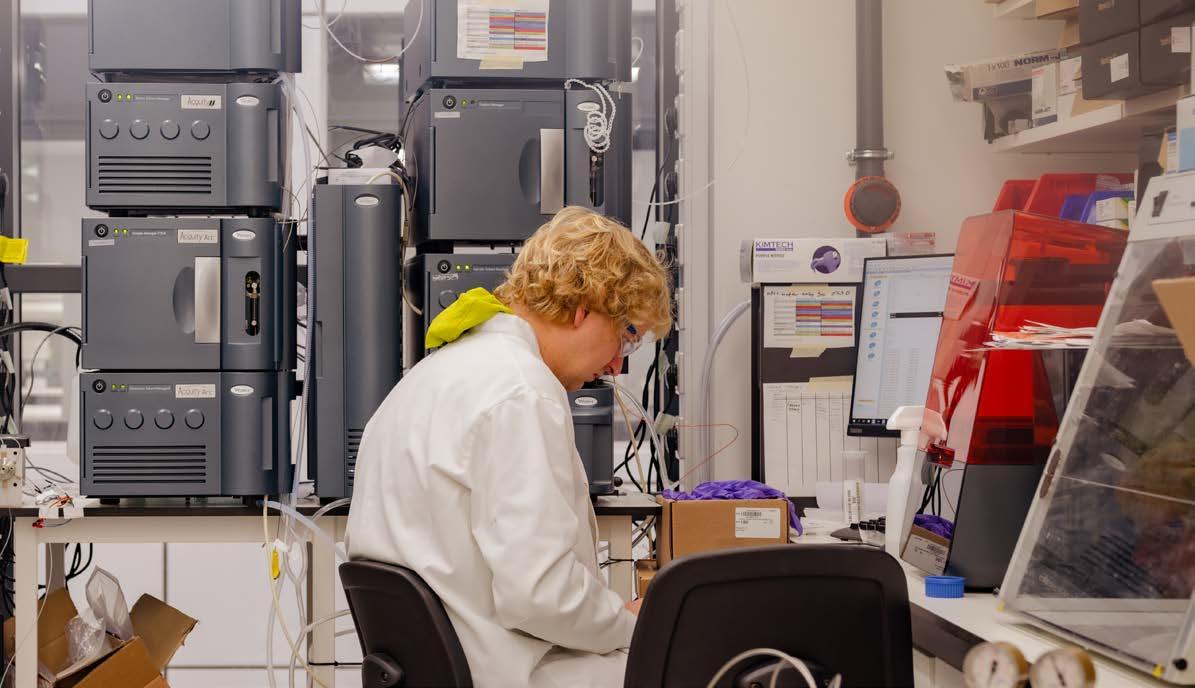

We have also established a cross-DDU Chemistry Advisory Board to assist with our translational research by advising on chemistry methodologies and strategies. This group of experts provides more direct support to our chemistry teams and portfolio leaders across the DDU to identify optimal ways of delivering research objectives and assessing innovative methodologies and approaches.
→ Professor Varinder Aggarwal, Professor in Synthetic Chemistry, University of Bristol
→ Professor Tim Cernak, Assistant Professor of Medicinal Chemistry and Chemistry, University of Michigan
→ Dr David Lathbury, Astute Chemical Development Consulting Ltd
→ Dr Paul Leeson, Director at Paul Leeson Consulting Ltd
→ Professor Adam Nelson, Professor of Chemical Biology, University of Leeds
→ Dr Steve Taylor, Founding Director at Celbius Ltd
Bakthavatchalam, Y. D., et al. (2023). In Vitro Activity of Two Cefepime-Based Novel Combinations, Cefepime/ Taniborbactam and Cefepime/Zidebactam, against Carbapenemase-Expressing Enterobacterales Collected in India. Microbiology Spectrum, 11(2) e04925-22. doi.org/10.1128/spectrum.04925-22
Bergkessel, M., Forte, B., & Gilbert, I. H. (2023). Small-Molecule Antibiotic Drug Development: Need and Challenges. ACS Infectious Diseases, 9(11), 2062–2071. doi.org/10.1021/acsinfecdis.3c00189
Braillard, S., et al. (2023). DNDI-6174 is a preclinical candidate for visceral leishmaniasis that targets the cytochrome bc1. Science Translational Medicine, 15(726), eadh9902. doi.org/10.1126/scitranslmed.adh9902
Brandon, A. M., et al (2023). Log D7.4 and plasma protein binding of synthetic cannabinoid receptor agonists and a comparison of experimental and predicted lipophilicity. Drug Testing and Analysis, 2023; 1-14. doi.org/https://doi.org/10.1002/dta.3621
Caldwell, N., et al (2023). Perspective on Schistosomiasis Drug Discovery: Highlights from a Schistosomiasis Drug Discovery Workshop at Wellcome Collection, London, September 2022. ACS Infectious Diseases, 9(5), 1046–1055. doi.org/10.1021/acsinfecdis.3c00081
Cameron, A., Floyd, A., Hardee, E., Mackintosh, A., & StanleyWall, N. (2023a). Public Engagement with Research and Scholarship Evaluation Framework 2023-2028. discovery.dundee.ac.uk/en/publications/public-engagementwith-research-and-scholarship-evaluation-framew
Cameron, A., Floyd, A., Hardee, E., Mackintosh, A., & StanleyWall, N. (2023b). Using An Evaluation Framework to Direct Public Engagement Work: 2017-2022 with Case Studies. discovery.dundee.ac.uk/en/publications/using-an-evaluationframework-to-direct-public-engagement-work-20
Cleghorn, L. A. T., et al (2023). Development of a 2,4-Diaminothiazole Series for the Treatment of Human African Trypanosomiasis Highlights the Importance of Static–Cidal Screening of Analogues. Journal of Medicinal Chemistry66(13) 8896–8916. doi.org/10.1021/acs.jmedchem.3c00509
De Rycker, M., Wyllie, S., Horn, D., Read, K. D., & Gilbert, I. H. (2023). Anti-trypanosomatid drug discovery: progress and challenges. Nature Reviews. Microbiology, 21, 35–50. doi.org/10.1038/s41579-022-00777-y
Gilbert, I. H., Vinayak, S., Striepen, B., Manjunatha, U. H., Khalil, I. A., Van Voorhis, W. C., Cryptosporidiosis Therapeutics Advocacy Group CTAG, & Cryptosporidiosis Therapeutics Advocacy CTAG. (2023). Safe and effective treatments are needed for cryptosporidiosis, a truly neglected tropical disease. BMJ Global Health, 8(8), e012540. doi.org/10.1136/bmjgh-2023-012540
González, S., et al (2023). Short-course combination treatment for experimental chronic Chagas disease. Science Translational Medicine, 15(726), eadg8105. doi.org/10.1126/scitranslmed.adg8105
Green, S. R., et al (2023). Identification and Optimization of Novel Inhibitors of the Polyketide Synthase 13 Thioesterase Domain with Antitubercular Activity. Journal of Medicinal Chemistry 66(22) 15380–15408. doi.org/10.1021/acs.jmedchem.3c01514
Guareschi, R., Lukac, I., Gilbert, I. H., & Zuccotto, F. (2023). SophosQM: Accurate Binding Affinity Prediction in Compound Optimization. ACS Omega, 8(17), 15083–15098. doi.org/10.1021/acsomega.2c08132
Hanna, J. C., et al (2023). Mode of action studies confirm ontarget engagement of lysyl-tRNA synthetase inhibitor and lead to new selection marker for Cryptosporidium . In Frontiers in Cellular and Infection Microbiology (Vol. 13). frontiersin.org/articles/10.3389/fcimb.2023.1236814
Makarov, A., et al (2023). The role of invariant surface glycoprotein 75 in xenobiotic acquisition by African trypanosomes. Microbial Cell, 10(2), 18–35. doi.org/10.15698/mic2023.02.790
Manesh, A., et al (2023). Clinical and Genomic Evolution of Carbapenem-Resistant Klebsiella pneumoniae Bloodstream Infections over Two Time Periods at a Tertiary Care Hospital in South India: A Prospective Cohort Study. Infectious Diseases and Therapy, 12(5), 1319–1335. doi.org/10.1007/s40121-023-00803-3
Martin, J. S., Mackenzie, C. J., Lin, D., Homeyer, N., Gray, D. W., Zuccotto, F., & Gilbert, I. H. (2023). Design and Synthesis of Covalent Inhibitors of FabA. ACS Omega, 8(14), 12787–12804. doi.org/10.1021/acsomega.2c08031
Miglianico, M., et al (2023). Assessment of the drugability of initial malaria infection through miniaturized sporozoite assays and high-throughput screening. Communications Biology, 6(1), 216. doi.org/10.1038/s42003-023-04599-3
Thomas, M. G., et al (2023). Structure-Guided Design and Synthesis of a Pyridazinone Series of Trypanosoma cruzi Proteasome Inhibitors. Journal of Medicinal Chemistry. 66(15) 10413–10431. doi.org/10.1021/acs.jmedchem.3c00582
Tomasi, F. G., et al (2023). Peptidyl tRNA Hydrolase Is Required for Robust Prolyl-tRNA Turnover in Mycobacterium tuberculosis. MBio, 14(1), e03469-22. doi.org/10.1128/mbio.03469-22
Tulloch, L. B., et al (2023). RES-Seq—a barcoded library of drugresistant Leishmania donovani allowing rapid assessment of cross-resistance and relative fitness. MBio, 14, e01803-23. doi.org/10.1128/mbio.01803-23
Webster, L. A., Farrell, S. J., Gilbert, I. H., Wyatt, P. G., & Read, K. D. (2023). “Bespoke Drug Discovery Training for Low-Middle Income Countries.” ACS Medicinal Chemistry Letters, 14(11), 1602. doi.org/10.1021/acsmedchemlett.3c00399
Wilson, C., et al (2023). Design of the Global Health chemical diversity library v2 for screening against infectious diseases. PLOS Neglected Tropical Diseases, 17(12), e0011799. doi.org/10.1371/journal.pntd.0011799

In 2023, members of the DDU contributed to the #WHY DUNDEE campaign with BioDundee, Invest Dundee,the University of Dundee and Vivomotion Ltd.
The Campaign launched in March 2022 on LinkedIn to put names and faces to the BioDundee community, of which the DDU is a proud member. BioDundee is a partnership between the public, private, academic and third sector organisations of the city. The purpose is to build the strength of Life Sciences and Healthcare sectors in Dundee and the wider Tayside region internally and promoting and positioning the region to relevant audiences externally as fundamentally contributing to Scotland’s world class Life Sciences and Healthcare sectors.
As the DDU is committed to its work in neglected infectious diseases, we strategically timed our “WhyDundee?” posts with WHO global health days in which we run drug discovery projects:
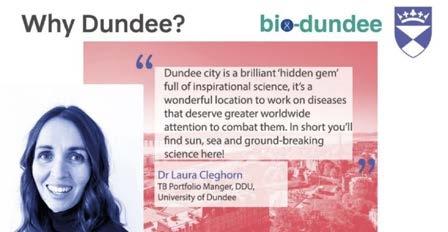

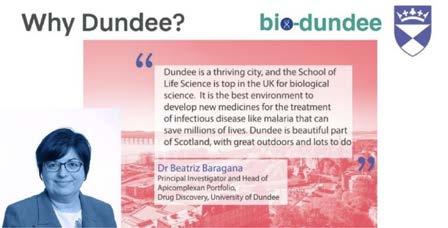
World TB Day, 24th March 2023
Laura Cleghorn who leads our TB Portfolio spoke about the inspirational science of Dundee.

World Chagas Disease Day, 14th April 2023
Manu De Rycker our Kinetoplastid Portfolio lead spoke about why Dundee is the place to carry out groundbreaking Chagas Disease research.
World Malaria day, 25th April 2023
Beatriz Baragana, our Apicomplexan Portfolio lead talked about why Dundee is such a good place to develop new treatments for infectious diseases.



Photography unless otherwise credited by John
Thank you
Post.
Drug Discovery Unit
School of Life Sciences
University of Dundee
Dow Street
Dundee DD1 5EH
ContactDDU@Dundee.ac.uk
ddu_dundee
drug-discovery-unit-university-of-dundee
drugdiscovery.dundee.ac.uk